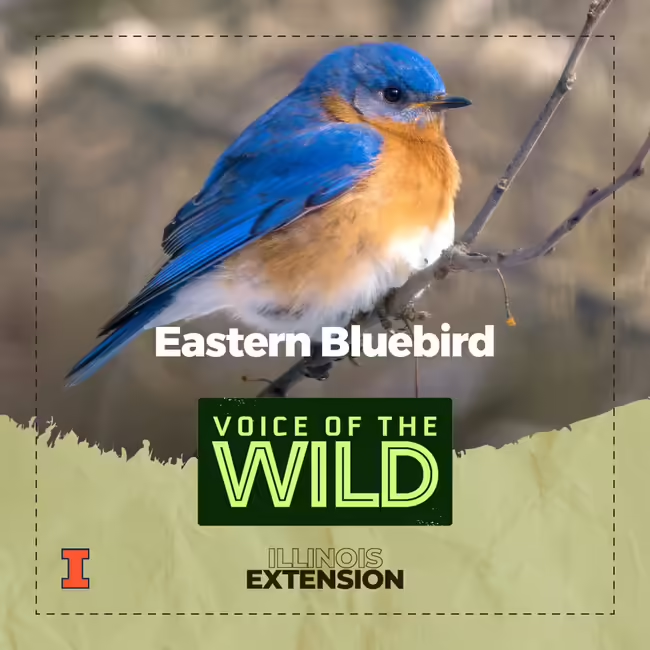
Episode Number
27
Episode Show Notes / Description
Eastern Bluebird (Sialia sialis).
The beloved Eastern Bluebird is a conservation success story that shows the huge impact of dedicated conservation and stewardship actions. The bird’s musical and somewhat variable churring can be heard in scrubby meadows and forest clearings, especially when there are dead snags with old woodpecker holes present (or well-kept birdhouses.)
Do you want to learn more bird songs, frog calls, and insect noises? Join Voice of the Wild every Friday to explore a new wild voice. We’re available on most podcast platforms, including Apple Podcasts, Spotify, and YouTube.
Subscription links Here
Subscribe to the Newsletter
Listen online on our Homepage
The following Cornell Lab | Macaulay Library recordings were used in this episode:
Eastern Bluebird song by Gregory Budney (ML508598)
Eastern Bluebird Chattering Calls by Wil Hershberger (ML508605)
Eastern Bluebird call by William Evans (ML508606)
Sources and more:
- https://www.nps.gov/ever/learn/nature/bluebird.htm
- https://www.invasivespeciesinfo.gov/terrestrial/vertebrates/european-starling
- https://www.audubon.org/field-guide/bird/eastern-bluebird
- https://www.allaboutbirds.org/guide/eastern_bluebird/overview
- Sibley, David. Sibley Birds East: Field Guide to Birds of Eastern North America. Second edition. New York: Alfred A. Knopf, 2016. Print.
- Peterson, Roger Tory, and Virginia Marie Peterson. A Field Guide to the Birds: A Completely New Guide to All the Birds of Eastern and Central North America. Fourth edition, completely revised and enlarged. Boston: Houghton Mifflin Company, 1980. Print.
- Godfrey, Michael A, John Farrand, and Roger Tory Peterson. Videoguide to the Birds of North America. New York, N.Y: MasterVision, 1985. Film.
Transcript
This is Illinois Extension’s Voice of the Wild. A new wild voice in just a moment, so find someplace quiet, take a deep breath, and enjoy.
The subject of song, poem, fairytale, and folklore; this blue, white, and rusty red bird is a strong contender for America’s most beloved animal. So, it's hard to believe we almost lost it. Their population dwindled throughout the early 1900’s - primarily because of competition for nesting cavities with the invasive European Starling. Around the 1960’s, folks started providing birdhouses with entrances just a little too small for the starling, and placed them along dedicated trails abutting appropriate habitat, scrubby meadows and forest clearings. Combined with pesticide reform, that simple intervention led to the species’ recovery. With their population stable, they’ve become a symbol in yet another story - one that tells of the power of stewardship.
This is the eastern bluebird (Sialia sialis) from the family of thrushes, Turdidae. The Eastern Bluebird has several kinds of vocalizations; two of them, its song and regular call, are given with the same breathy melancholic voice. It also makes stuttering “chit” noises and these can sound somewhat sparrowlike. Here’s the Eastern Bluebird again - listen for the sparrowlike chattering among its musicals churrs.
Thank you to the Macaulay library at the Cornell lab for our bird sounds. And thank you for tuning in to learn a new wild voice with Illinois Extension.
The subject of song, poem, fairytale, and folklore; this blue, white, and rusty red bird is a strong contender for America’s most beloved animal. So, it's hard to believe we almost lost it. Their population dwindled throughout the early 1900’s - primarily because of competition for nesting cavities with the invasive European Starling. Around the 1960’s, folks started providing birdhouses with entrances just a little too small for the starling, and placed them along dedicated trails abutting appropriate habitat, scrubby meadows and forest clearings. Combined with pesticide reform, that simple intervention led to the species’ recovery. With their population stable, they’ve become a symbol in yet another story - one that tells of the power of stewardship.
This is the eastern bluebird (Sialia sialis) from the family of thrushes, Turdidae. The Eastern Bluebird has several kinds of vocalizations; two of them, its song and regular call, are given with the same breathy melancholic voice. It also makes stuttering “chit” noises and these can sound somewhat sparrowlike. Here’s the Eastern Bluebird again - listen for the sparrowlike chattering among its musicals churrs.
Thank you to the Macaulay library at the Cornell lab for our bird sounds. And thank you for tuning in to learn a new wild voice with Illinois Extension.